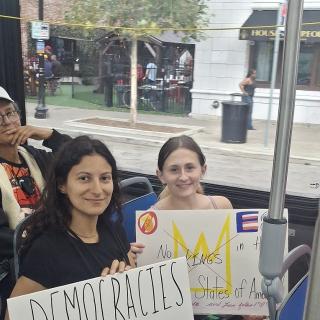Advertisement
Planned Parenthood of Greater Ohio (PPGOH) has finally unionized after a card count in which 65 percent of eligible employees voted to unionize on Thursday, February 7, 2025.
After the Federal Mediation and Conciliation Service (FMCS), which is a government agency that helps mediate and resolve labor-management disputes, confirmed that the cards were authentic and had 65 percent support, leadership voluntarily recognized that the union had unequivocally garnered overwhelming support, clearly more than the majority that was needed, according to Olivia Oney, Regional Field Manager of Planned Parenthood Advocates of Ohio.
Under the guidelines of the National Labor Relations Act, outlined in Basic Steps to Forming a Union, PPGOH employees can now begin bargaining. Oney explained that this means that employees at PPGOH now have protections and that management “can’t unilaterally change anything about our positions or jobs or wages, schedules, etc. until we’ve negotiated our contract or at the very least, they would have to approve them [changes] through the union and the union would have to talk to us and approve them through us. So we have protections in place now so that they can’t retaliate before a contract.”
PPGOH comprises three organizations (Planned Parenthood of Northeast Ohio, Planned Parenthood of Central Ohio, and Planned Parenthood Affiliates of Ohio) that merged in 2012. PPGOH operates 13 health centers that serve a 68 county region. Their advocacy arm, Planned Parenthood Affiliates of Ohio Fund, was renamed Planned Parenthood Advocates of Ohio when these centers were merged into PPGOH. In 2023, PPGOH began offering telehealth care at its Virtual Health Center, and in 2024, it opened a first-of-its-kind community pharmacy, PPRx, in Akron, Ohio.
In its most recent report PPGOH stated that it conducted 16,817 pregnancy tests and 86,346 STI tests, served 11,803 contraceptive patients, completed 7,136 telehealth visits, and made 3,255 gender-affirming care visits. Most patients had low incomes and relied on Medicaid or paid out of pocket for care. Most were female (85 percent) and White (51 percent White and 33 percent Black), and 46 percent relied on Medicaid to access care.
The impetus for unionizing started after PPGOH closed three health centers and laid off employees in January 2024. After an announcement that the centers were closing, employees who were laid off were notified by email. Many of the employees who were let go had received excellent performance reviews and expected bonuses, but they were taken away before they went into effect due to “financial concerns.” Other employees became frightened about future layoffs, which led to high turnover rates, and identified multiple factors that had arisen that had led to worsening work conditions.
Many employees felt overworked without adequate compensation. Oney explained that employees often had to “stay late because they were given too many appointments” and not get overtime. Patients at health centers such as Planned Parenthood have complex physical and emotional needs that require workers to overextend themselves. Burnout among employees is especially high at Planned Parenthood and contributes to “ a lot of turnover,” says Oney. She adds that employees “don’t make enough money. Some make only $17 an hour.” Although Planned Parenthood employees have attempted to organize in the past they encountered various obstacles and challenges that impeded unionizing.
However, recent state and national cuts, including greater threats to abortion, have further strained all Planned Parenthood organizations, especially in Ohio. Their press release on November 7, 2024 underscored that the recent election favored many candidates “who prioritize ideology over public health, but it does not change what we know to be true: a majority of Ohioans believe that abortion access is a right. Our doors [PPOGH] will continue to be open to offer care to all those who need it.”
However, given recent state and national changes in administration Planned Parenthood organizations face huge financial losses due not only from threats from state and national government funding as well as from private donations, which supply substantial revenue. Oney explains, “we had some insight into what it could look like, but we just don’t know what he’s [Trump] going to do next.” For example, U.S. agents of the Immigration and Customs Enforcement (ICE) office are now allowed to enter health centers.
Oney explained that “They haven’t done that yet in our health centers at this point, but there’s always that fear. We know that if they have the opportunity to target our health center, they probably will, so [we] just kind of try to prepare for if that were to happen, we’ve put together some processes and resources for our staff and employees and just everybody in general like our patients we plan to protect them as much as we physically can. But it’s definitely a scary time.”
Finally, perhaps the most serious issue facing PPGOH and their workers is recent legislation that will adversely affect services to Ohio’s most vulnerable populations. According to Oney, their center serves many Spanish-speaking and low income patients. Oney explains that “We’re offering free health care to those folks and want to make sure we are offering health care in a way that actually addresses their needs instead of rushing them out...”. In addition, in a press release on January 9, 2025, PPGOH expressed concern that the controversial “Don’t Say Gay” bill, which Governor DeWine signed into law, will undermine evidence-informed sexual health education and target LGBTQ+ students. This legislation goes into effect on April 8, 2025.
When asked how the public could best support PPGOH, Oney explained that they are still in a stage of transition and will need more public support once they start bargaining. Public pressure increases management’s willingness to negotiate and bargain with workers. Oney explained that “we will definitely want some public support” and that “social media stuff has been a godsend...because without it I don’t know they [management] would’ve immediately voluntarily recognized to the degree that they did because they turned around and pretty much did that within a week but it was because we had sent like thousands of letter and our board put a lot of pressure to do something so those letters would stop essentially and they did that. They asked us to stop those letters when they were originally talking to us about voluntary recognition. So we know the public pressure campaigns are helpful.” The negotiations for a new contract have not yet been scheduled.



